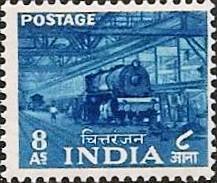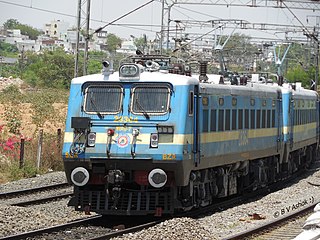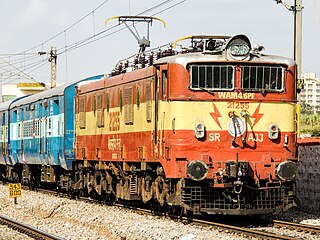Related Research Articles

Indian locomotive class WAP-5 is a class of electric locomotives used by Indian Railways. The first ten locomotives were imported from ABB in Switzerland in 1995 and later manufactured by Chittaranjan Locomotive Works in India. On 3 July 2014, a WAP-5 set an Indian speed record by hauling a train between Delhi and Agra at a speed of 160 km/h (99 mph). The locomotive has regenerative braking, flexible gear coupling, wheel-mounted disc brakes, and a potential for speed enhancement to 200 km/h (120 mph). Braking systems include 160 kN (36,000 lbf) regenerative brakes, disc brakes, automatic train air brakes and a charged spring parking brake.

The Indian locomotive class WAP-7 is a class of 25 kV AC electric locomotives that was developed in 1999 by Chittaranjan Locomotive Works (CLW) for Indian Railways. The model name stands for broad gauge (W), AC Current (A), Passenger traffic (P) locomotive, 7th generation (7). They entered service in 2000. A total of 1532 WAP-7 have been built, with more units being built at CLW, Banaras Locomotive Works (BLW) and Patiala Locomotive Works (PLW).

Chittaranjan Locomotive Works (CLW) is an electric locomotive manufacturer based in India. The works are located at Chittaranjan in the Asansol Sadar subdivision of West Bengal, with an ancillary unit in Dankuni. The main unit is 32 km from Asansol and 237 km from Kolkata. CLW has stores and offices in Kolkata, as well as inspection cells in New Delhi, Mumbai, Kolkata, and Bangalore. It is the largest locomotive manufacturer unit in the world, producing 431 locomotives in 2019–20.

The Indian locomotive class WAG-7 is a class of 25 kV AC electric locomotives that was developed in 1990 by Chittaranjan Locomotive Works for Indian Railways. The model name stands for broad gauge (W), alternating current (A), goods traffic (G) engine, 7th generation (7). They entered service in 1992. A total of 1970 WAG-7 were built at CLW and BHEL between 1990 and 2015, which made them the most numerous class of mainline electric locomotive till its successor the WAG-9.

The Indian locomotive class WAM-4 is a class of 25 kV AC electric locomotives that was developed in 1970 by Chittaranjan Locomotive Works for Indian Railways. The model name stands for broad gauge (W), alternating current (A), mixed traffic (M) locomotive, 4th generation (4). They entered service in March 1971. A total of 500 WAM-4 were built at CLW between 1970 and 1983, which made them the most numerous class of mainline electric locomotive till its successor the WAG-5.

The Indian locomotive class WAP-1 is a class of 25 kV AC electric locomotives that was developed in 1980 by Chittaranjan Locomotive Works for Indian Railways. The model name stands for broad gauge (W), AC Current (A), Passenger traffic (P) locomotive, 1st generation (1). They entered service in late 1981. A total of 65 WAP-1 were built at CLW between 1980 and 1996, which made them the most numerous class of mainline electric passenger locomotive until its successor, the WAP-4.

The Indian locomotive class WCG-2 is a class of 1.5 kV DC electric locomotives that was developed in the late 1960s by Research Design and Standards Organisation (RDSO) and Chittaranjan Locomotive Works (CLW) for Indian Railways. The model name stands for broad gauge (W), DC Current (C), Goods traffic (G) engine, 2nd generation (2). They entered service in February 1971. A total of 57 WCG-2 were built at CLW between 1978 and 1983, which made them the most numerous class of DC electric locomotive.
The Indian locomotive class WDS-6 is a diesel-electric locomotive used by the Indian Railways mainly for shunting and also for performing departmental duties. The model name stands for broad gauge (W), Diesel (D), Shunting (S) engine, 6th generation (6). As of April 2022, 375 units of this class are currently in use all over India.

The WDS-4 also known as Pappu is a class of diesel-hydraulic locomotive used by Indian Railways for shunting and departmental operations. The model name stands for broad gauge (W), Diesel (D), Shunting (S) engine. The WDS-4 was once used all over India but most have now been scrapped or condemned from active service.

The Indian locomotive class YDM-1 is a class of diesel-Hydraulic locomotive that was developed in 1954 by North British Locomotive Company (NBL) for Indian Railways. The model name stands for Metre gauge (Y), Diesel (D), Mixed traffic (M) engine, 1st generation (1). They entered service in 1955. A total of 20 YDM-1 locomotives was built between 1954 and 1956, which made them among the first MG main-line diesels.
The Indian locomotive class YDM-2 is a class of diesel-Hydraulic locomotive that was developed in 1986-90 by Chittaranjan Locomotive Works for Indian Railways. The model name stands for Metre gauge (Y), Diesel (D), Mixed traffic (M) engine, 2nd generation (2). They entered service in 1986. A total of 41 YDM-2 locomotives was built between 1986 and 1990.
The Indian locomotive class WCM-6 is a class of 1.5 kV DC electric locomotives that was developed in 1995 by Chittaranjan Locomotive Works (CLW) for Indian Railways. The model name stands for broad gauge (W), Direct Current (C), Mixed traffic (M) engine, 6th generation (6). They entered service in 1996. A total of 2 WCM-6 locomotives was built at CLW in 1995. Currently they haul only departmental trains and do shunting duties.
The Indian locomotive class WCM-5 is a class of 1.5 kV DC electric locomotives that was developed in 1956 by Chittaranjan Locomotive Works (CLW) for Indian Railways. The model name stands for broad gauge (W), Direct Current (C), Mixed traffic (M) engine, 5th generation (5). The trains were the first locomotive of any kind fully developed and built in India. They entered service in 1961. A total of 21 WCM-5 locomotives was built at CLW between 1961 and 1963.

The class WDS-5 is a diesel-electric locomotive used by Indian Railways for shunting and doing departmental works. The model name stands for broad gauge (W), Diesel (D), Shunting (S) engine. The WDS-6 is used all over India.
The class WDS-3 was a diesel-hydraulic locomotive used by Indian Railways for shunting and doing departmental works. The model name stands for broad gauge (W), diesel (D), shunting (S) 3rd generation (3). The WDS-3 is used mostly in the Northern Railway Zone (NR). All these locomotives were withdrawn and scrapped by the late 1990s.

The class WDS-1 was a diesel-electric locomotive used by Indian Railways for shunting and doing departmental works. The model name stands for broad gauge (W), Diesel (D), Shunting (S) 1st generation (1). The WDS-1 is used mostly in the Northern Railway Zone (NR). All these locomotives were withdrawn by the late 1990s.

The Indian locomotive class WAG-1 was a class of 25 kV AC electric locomotives that was imported from Europe in the 1960s for Indian Railways. The model name stands for broad gauge (W), AC Current (A), Goods traffic (G) locomotive, 1st generation (1). A total of 112 WAG-1 were built by The European Group 50 Hz Group/European Group/50 Cycles Group (consortium) between 1963 and 1966. They entered service in 1964.

The Indian locomotive class WAG-4 is a class of 25 kV AC electric locomotives that was manufactured by CLW in the late 1960s for Indian Railways. The model name stands for broad gauge (W), AC Current (A), Goods traffic (G) engine, 1st (1). A total of 186 WAG-4 locomotives were built by The European Group 50 Hz Group/European Group/50 Cycles Group (consortium) between 1967 and 1969. They entered service in 1967.
The Indian locomotive class WAG-8 is a class of 25 kV AC electric locomotives that was developed in the early 1990s by Bharat Heavy Electricals Limited (BHEL) for Indian Railways. The model name stands for broad gauge (W), AC current (A), freight/goods traffic (G), eighth-generation (8). Only two units of this class were built, both prototypes.
The Indian locomotive class WAP-3 was a class of 25 kV AC electric locomotives that was designed by Research Design and Standards Organization (RDSO) and Chittaranjan Locomotive Works (CLW) for Indian Railways in 1987. The model name stands for Broad gauge (W), AC Current (A), Passenger traffic (P) locomotive, 3rd generation (3). They entered service in 1988. They were the faster variant of the previous WAP-1 class. A total of 9 WAP-3 were converted from existing WAP-1 units at CLW between 1987 and 1988. All locomotives were now withdrawn from service and converted back to WAP-1.
References
Notes
- ↑ "[IRFCA] Indian Railways FAQ: Diesel and Electric Locomotive Specifications". www.irfca.org. Retrieved May 22, 2020.
- ↑ "[IRFCA] Indian Railways FAQ: Locomotives -- Specific classes : AC Electric". www.irfca.org. Retrieved May 22, 2020.
- ↑ "[IRFCA] Indian / South-Asian Industrial Locos : Builders: Chittaranjan Locomotive Works". www.irfca.org. Retrieved May 22, 2020.
Bibliography
- Hughes, Hugh (1996). Indian Locomotives: Part 4 – 1941–1990. Harrow, Middlesex: The Continental Railway Circle. ISBN 0-9521655-1-1. OCLC 35135033.



